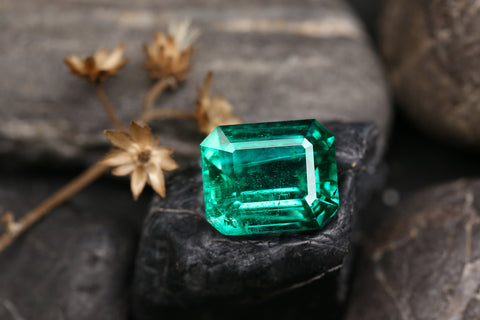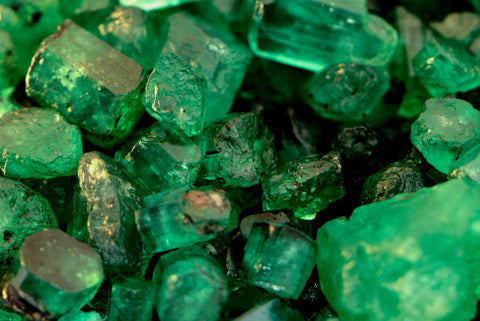10 Things You Didn’t Know About Emerald
More crystal meanings on our blog at www.crystalgemstones.net
Emerald, the stone of the heart, sought after not only for its vibrant green beauty, but also for its ability to fill any space with love and harmony. Its symbolism encompasses royalty, wit, eloquence, foresight, and immortality having lived in the hearts and cultures of many throughout history. Considered a superior jewel, it is rare and beautiful, with many mystical properties. An exceptionally vibrant green variety of beryl, it is most commonly found in Brazil, Russia, Africa, and Egypt. Emerald instills healing, passion, and sensuality, while allowing us to manifest our deepest desires into reality. Whatever speculation exists surrounding this magical green stone, its beauty is undeniable. Let’s take a peek into the past as we explore ten things you didn’t know about Emerald.

1. Emerald – the origins of a name
Quite plainly (unlike the stone itself), the name is derived from the Greek word smaragdus, meaning “green stone”. Roman Pliny the Elder described Emerald in his Natural History, published first century A.D.: “…nothing greens greener.” He also described the use of emeralds by early lapidaries, who “have no better method of restoring their eyes than by looking at an emerald, its soft green color comforting and removing their weariness and lassitude.” Still today, the color green is known to relieve stress and eye strain.
2. Emerald in Ancient Egypt
The first ever known Emerald mines were in Egypt, dating back to 330 B.C. into the 1700’s. Cleopatra herself claimed these mines from the Greek and often adorned herself and her chambers with the stone, gifting it to foreign ambassadors – this is said to have been more a display of her own power rather than to strengthen international ties. Whenever visiting dignitaries left Egypt, she would present them with her likeness carved into this green stone. The ancient Egyptians shared with the rest of the world the belief that emeralds could cure eye diseases and that its color represented fertility and rebirth. The dead were often buried with the stone to symbolize eternal youth.
3. Emerald as a Talisman
The belief that emeralds hold a special power spanned across the world, influencing many cultures and civilizations. They were believed to bring riches, power, eloquence, as well as strength of memory and a sharp wit. Perhaps the most valuable of its powers was its gift of being able to see into the future. It was said that placing an emerald under the tongue would bestow foresight as well as reveal truth and protect against evil spells. Many people also believed that emeralds could protect against possession by demons.

4. Emerald, a Stone for Lovers
Emerald has long since been known as a revealer of truth. It is reputed to be able to cut through lies and deceit, illusions and spells, especially the falsity of a lover’s oath. Some also believed that emeralds could dampen lust and perhaps allow one to see an object of infatuation for what it is, instead of as love.
5. Emerald Cities and Symbolism
Emerald’s vibrant green color ensured it was always associated with the lushest landscapes and richest greens. Many ancient Indian tales tell of legendary and mysterious cities abundant in wealth, with walls and entire temples made of emerald. Images and paintings of plants with leaves dripping emeralds and rubies would suggest a great fortune upon those lucky enough to find these cities. Stories like this spread across Europe and of course, when the Spaniards arrived in these lands and found gold as well as emeralds, they believed they were true. Emerald’s association with wealth and abundance fascinated the rest of the world to the point of naming places after the stone: Ireland is the “Emerald Isle”, Seattle is the “Emerald City”… Even Thailand’s most sacred religious icon is called the “Emerald Buddha” (although it is actually made of jadeite).
6. Emerald in Christian History
The bible is no stranger to crystals and gemstones, although their identification was not yet accurate in those times. On the famous Breastplate of Aaron (or the High Priest’s Breastplate) one of the twelve stones were believed to be Emerald, although it might have been peridot since the two were often confused throughout history. In the bible, it is also stated that one of the four rings presented to King Solomon by God was in fact set with an emerald. Emerald, together with the other three stones were said to have bestowed upon the king, power over all creation.

7. Emerald, an Offering to the Gods
Perhaps because of Emerald’s association with abundance, fertility, and eternal life, it was often used in rituals and ceremonies by many ancient cultures and civilizations. The natives of northern South America would burn gold and emeralds before images of the sun and moon Gods, their highest divinities. The Hindus also believed that making offerings of emerald to Krishna would be rewarded as “givers are high in heaven”, they will receive “knowledge of the soul and the eternal.” Hindus also associate emerald with the planet Mercury and believed that in the gods generously rewarded such givings. In more Western culture, the stone is associated with the Greek goddess Venus (a symbol of love and hope) and her emergence from the sea, particularly the sea foam green variety of emerald.
8. Emerald, the Goddess Umina, and her Daughters
In the Peruvian city of Manta, around 1532, the people worshiped an emerald the size of an ostrich egg, believing it to be the goddess Umina. According to the priests who brought her out only on her “feast days”, she was to be worshiped by bringing her (the mother emerald), her daughters (smaller emeralds) as offerings. When the Spaniards invaded the town, they seized this large store of emeralds, but could not find Umina as she was carefully hidden. Insistent on determining whether the stones were real (and failing to realize that emeralds do not withstand such force), they smashed them with an anvil.
9. Emerald and the Heavenly City
The New Testament and the book of Revelation, tells the story of the foundation stones and the Heavenly city, one of which was emerald. Archbishop Rabanus Maurus of Mainz wrote about the significance of the twelve apocalyptic gems (considered by some to be the 12 stones on the breastplate of Aaron). He wrote that “in the emerald is expressed the strength of faith in adversity”. These stones were also frequently associated with the twelve apostles, of which Andreas, bishop of Caesarea said “the emerald which is of green color, nourished with oil, that its transparency and beauty may not change; we conceive this stone to signify John the Evangelist. He, indeed, soothes the souls dejected by sin with a divine oil, and by the grace of his excellent doctrine lends constant strength to our faith.”

10. Emerald in Physical Healing
Beyond all the lore and superstitions surrounding emeralds, they were often used in physical healing as well. The soothing color of this stone was thought to relieve eye strain and gem cutters would keep them on the workbench to rest their eyes on after long hours of work. Emerald was also once believed to cure cholera and malaria. In past times, Arab, Hindu, and Spanish physicians would often use emeralds against poison, infection and dysentery. Dating as far back as 1242, there was a belief that a snake would lose its eyesight if it looked upon an emerald.
Birthstone: May
Anniversary: 35th
Zodiac: Aries, Taurus, Gemini
Planet: Venus
Chakra: Heart
Element: Water
Colors: green
